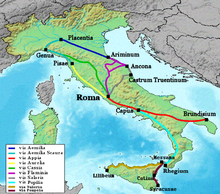
Back Касіева дарога Byelorussian Виа Касия Bulgarian Via Càssia Catalan Via Cassia Czech Via Cassia German Vía Cassia Spanish Via Cassia Finnish Via Cassia French Via Cassia Hungarian Via Cassia ID


The Via Cassia (lit. 'Way of Cassius') was an important Roman road striking out of the Via Flaminia near the Milvian Bridge in the immediate vicinity of Rome and, passing not far from Veii, traversed Etruria.[1] The Via Cassia passed through Baccanae, Sutrium, Volsinii, Clusium, Arretium, Florentia, Pistoria, and Luca, joining the Via Aurelia at Luna.[2]
The Via Cassia intersected other important roads. At mile 11 the Via Clodia diverged north-north-west. At Sette Vene, another road, probably the Via Annia, branched off to Falerii. In Sutrium, the Via Ciminia split off and later rejoined.[3]
The date of its construction is uncertain: it cannot have been earlier than 187 BC, when the consul Gaius Flaminius constructed a road from Bononia to Arretium, which must have coincided with a portion of the later Via Cassia. It is not mentioned by any ancient authorities before the time of Cicero, who in 45 BC speaks of the existence of three roads from Rome to Mutina: the Flaminia, the Aurelia and the Cassia. A milestone of AD 124 mentions repairs to the road made by Hadrian from the boundary of the territory of Clusium to Florentia, a distance of 86 miles (138 km).[4]
- ^ Annapaola Mosca (2002). Via Cassia: un sistema stradale romano tra Roma e Firenze. Olschki. ISBN 9788822250919.
- ^ William Smith (1873). A Dictionary of Greek and Roman Geography. J. Murray. pp. 1297–.
- ^ Ashby 1911.
- ^ One or more of the preceding sentences incorporates text from a publication now in the public domain: Ashby, Thomas (1911). "Cassia, Via". In Chisholm, Hugh (ed.). Encyclopædia Britannica. Vol. 5 (11th ed.). Cambridge University Press. p. 458.